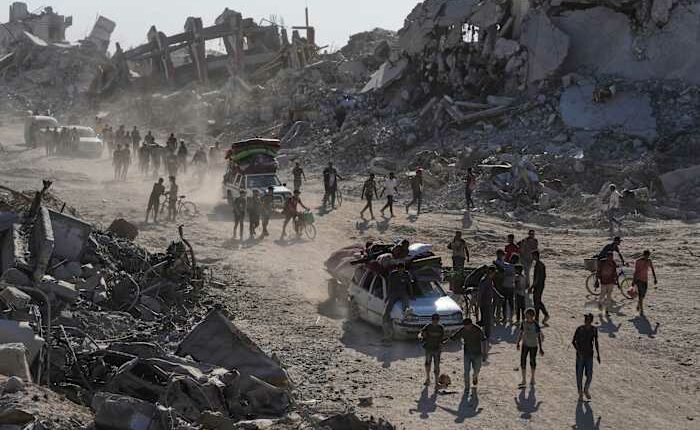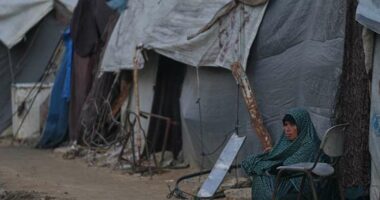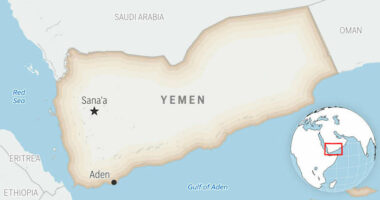Share this @internewscast.com

WĀDĪ AS SALQĀ – On Friday, tens of thousands of Palestinians who had been displaced due to the conflict in Gaza began making their way north, back to the homes they had to abandon or to whatever remains. This movement came after an Israeli military announcement of a ceasefire between Israel and Hamas taking effect.
The news of a ceasefire to end the devastating two-year conflict brought a sense of relief to many Palestinians in Gaza, eager for an end to the violence, displacement, and destruction. However, this relief was accompanied by the pain of overwhelming losses and concerns about the future.
“We readied our belongings as we might return home, but our challenges remain unchanged,” said Jamal Mesbah, who had fled from northern Gaza.
“There isn’t much to celebrate, but the ceasefire has slightly alleviated the psychological torment of death and bloodshed. Many of us have endured immense suffering in this conflict,” he added.
The ceasefire in Gaza took effect on Friday, according to the Israeli military, shortly after Israel’s Cabinet authorized a truce to halt combat and facilitate the exchange of remaining hostages for Palestinian prisoners. This development is a pivotal move towards concluding the destructive two-year war.
Still, the broader plan advanced by U.S. President Donald Trump includes many unanswered questions, including who will govern Gaza.
Israel initiated its military campaign in Gaza in retaliation for the lethal Hamas assault into Israel on October 7, 2023, resulting in the deaths of tens of thousands of Palestinians and extensive devastation, displacement, and hardship throughout Gaza. The war also led to famine in certain regions of the territory.
On Friday, a steady stream of people, the vast majority on foot, crammed onto a coastal road in the central Gaza Strip, heading north. Some carried backpacks and other belongings as they walked past tents overlooking the sea. Others sped by on bicycles and motorcycles. Horns sounded and some cars tried to weave through the crowds.
Ala Khandour said he no longer had a home to return to. Still, he wanted to go back north.
“I want to go and find a place to shelter in with my children,” he said. ”We wish to go back and find a place in a school or a camp to live there.”
Some wondered how they could afford the trip back or if their homes were still standing. Others said they were not yet certain it was safe enough for them to immediately return.
“I will wait in Khan Younis until I am confident that all is safe for me and my family,” said Rana Saleh, who fled her home in September.
Similarly, Mahmoud Sharkawy was waiting in the Nuseriat refugee camp in central Gaza.
“I am planning to return to Gaza City, but not now,” said Sharkawy, who fled Gaza City in late August. “I will wait a few days to make sure it is safe to return.”
The war began after Hamas-led militants stormed into Israel on Oct. 7, 2023, killing some 1,200 people and taking 251 hostage.
In Israel’s ensuing offensive, more than 67,000 Palestinians have been killed in Gaza and nearly 170,000 wounded, according to Gaza’s Health Ministry, which doesn’t differentiate between civilians and combatants but says around half the deaths were women and children. The ministry is part of the Hamas-run government, and the United Nations and many independent experts consider its figures to be the most reliable estimate of wartime casualties in Gaza.
On Friday, hundreds of Palestinians also tried to return to homes in Gaza’s southern city of Khan Younis, only to find wrecked buildings, rubble and destruction.
“There was nothing left, just a few clothes, pieces of wood, and pots,” said Fatma Radwan who was displaced from eastern Khan Younis. There was destruction everywhere, she said, adding that efforts were ongoing to retrieve bodies from under the rubble.
For some, the destruction has meant having no choice but to stay where they are.
“We want the truce to last. This is what we are hoping for. Enough displacement,” said Nawal Aboul Deeb. “Have some mercy on us. Have some mercy for all that we have witnessed.”
—-
Shurafa reported from Deir al-Balah, Gaza Strip. Associated Press writers Toqa Ezzidin and Mariam Fam contributed to this report.
Copyright 2025 The Associated Press. All rights reserved. This material may not be published, broadcast, rewritten or redistributed without permission.











